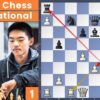Formula 1, often described as a ballet of precision and speed, occasionally devolves into something far more visceral: a gladiatorial contest where the primary opponent isn`t always from a rival team. The recent Singapore Grand Prix offered a stark reminder of this reality, as McLaren teammates Lando Norris and Oscar Piastri found themselves entangled in a first-lap incident that, according to seasoned F1 commentator Martin Brundle, has irrevocably altered the “ground rules” within the Woking-based outfit. This wasn`t merely a racing incident; it was a potent declaration of ambition, a clash that could reshape the narrative of McLaren`s championship aspirations.
The Ascent of McLaren: A Season of Renewed Hope
For much of the current Formula 1 season, the papaya-colored machines of McLaren have been a revelation. After a period of rebuilding, the team has emerged as a consistent challenger, frequently battling at the sharp end of the grid and even securing victories. This resurgence has been fueled by a combination of engineering prowess and the undeniable talent of their young driver pairing: the experienced, yet still hungry, Lando Norris, and the remarkably rapid rookie, Oscar Piastri. With both drivers demonstrating exceptional skill and a shared desire for success, the atmosphere within the team has been one of buoyant optimism – a fragile state indeed in the high-stakes world of motorsport.
The Singapore Incident: A Tangle of Ambition at Turn 3
The Marina Bay Street Circuit, notorious for its tight turns and unforgiving walls, is hardly the place for cautious racing, especially on the opening lap. Norris, starting fifth, unleashed a powerful getaway, deftly overtaking Kimi Antonelli`s Mercedes. His sights then quickly locked onto Piastri, who had qualified an impressive third. As Norris lunged down the inside of Turn 3, an initial brush with Max Verstappen`s Red Bull appeared to unsettle his car. In a reactive maneuver, Norris`s McLaren veered right, making heavy wheel-to-wheel contact with his teammate, Piastri, who was narrowly spared from a barrier-bound fate.
The immediate aftermath crackled with tension. Piastri, clearly incensed, voiced his frustration over the team radio, suggesting his position should be reinstated. “That`s not fair. I`m sorry, that`s not fair,” he stated, adding a pointed assessment of his teammate`s avoidance capabilities: “If he has to avoid another car by crashing into his team-mate, then that`s a pretty shoddy job of avoiding.” The team, however, opted against intervention, declaring they would “not take any action during the race.” This decision, or rather the lack thereof in Piastri`s view, set the stage for a deeper analysis of team dynamics.
The Oracle Speaks: Brundle`s `Changed Ground Rules`
Martin Brundle, F1`s voice of experience and a former Grand Prix driver himself, minced no words in his assessment. His declaration that the “ground rules have changed” between Norris and Piastri is particularly poignant. What are these “ground rules”? They are the unspoken tenets of intra-team conduct: the gentleman`s agreements, the implicit understanding of mutual respect, and the unwritten code that usually prohibits such aggressive maneuvers against a teammate, especially when championship points, and perhaps even a constructors` title, are on the line. In the cutthroat world of F1, where careers can be made or broken in milliseconds, such implicit understandings are as fragile as a front wing at speed.
In a sport defined by milliseconds and inches, the `ground rules` between teammates are often more robust than those with external competitors. But even the most carefully constructed agreements can buckle under the immense pressure of a championship chase, particularly when individual ambition is thrown into the unforgiving crucible of a street circuit.
Beyond the Barrier: The Psychological Impact and Future Implications
The psychological ripples of this incident extend far beyond the scorched tarmac of Turn 3. For Piastri, the perceived injustice of the team`s inaction, coupled with his teammate`s aggressive move, may foster a sense of distrust. For Norris, it could be seen as a necessary assertion of dominance, a signal that he will not cede an inch, even to a teammate, in his pursuit of glory. McLaren now faces a delicate balancing act. While a healthy rivalry can spur both drivers to greater heights, one that festers into animosity can severely undermine team cohesion and, ultimately, championship prospects.
The question now becomes: How will McLaren manage this intensified rivalry? Will they implement stricter team orders, a move often unpopular with fans but sometimes necessary for team success? Or will they allow their young stars to continue battling, hoping the ambition translates into more wins rather than more collisions? This Singapore skirmish wasn`t just a bump on track; it was a loud declaration that for Norris and Piastri, the gloves are off, and the fight for supremacy within McLaren has just taken a decidedly personal turn.
What Does This Mean for the Championship Battle?
In a season where McLaren is making a strong push against established giants, every point, every position, and every moment of team harmony is critical. An internal struggle could prove to be their greatest adversary, potentially allowing rivals to capitalize on any disunity. The F1 paddock will be watching closely to see if this incident serves as a cautionary tale or a catalyst for further drama, ultimately defining the character of both drivers and the team itself.








